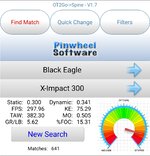Austin_Hall
FNG
- Joined
- Feb 7, 2022
- Messages
- 7
I've been playing around with different arrows since getting my v3 27 in July. I've mainly shot 300 spine (axis 4mm, x imact, and easton t64s), and had decent results. Is it possible I'm overspined? I was messing around on an arrow software site and it seems to think so. Could going to a lighter spine help in any way or should I stick to 300s? Does being over spine cause any issues? I'm shooting 68 pounds at 27" draw, arrows cut to 27" if that helps any.

